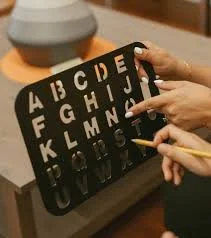What Is Spelling to Communicate (S2C)? A Portland Practitioner Explains the Motor-Based Approach
For many nonspeaking or minimally speaking individuals, the biggest barrier to communication isn’t language — it’s motor. As a Spelling to Communicate (S2C) Practitioner serving Portland, Sherwood, and the surrounding areas, the question I’m asked most often is:
“What exactly IS Spelling to Communicate?”
Here’s a clear explanation of the approach, the science behind it, and what Portland families can expect when beginning S2C.
S2C Is a Motor-Based Pathway to Communication
Unlike traditional speech therapy, which focuses on speech production, S2C targets the motor skills required for pointing to letters and spelling meaningful communication.
Why this matters:
Speech is 100% motor
Language is 100% cognitive
Many nonspeaking individuals fully understand language but struggle with the motor movements needed for speech. Differences in motor planning, apraxia, and unreliable automatic movement make speaking extremely difficult—even when cognition is strong.
S2C teaches purposeful movement of the arm, elbow, and shoulder to help a person reliably point to letters on a letterboard, and eventually a keyboard.
Why S2C Works
S2C is rooted in neuromotor science. It is effective because it:
1. Builds purposeful motor control
Starting with a 3-board system and progressing to the 26-board and keyboard.
2. Supports reliable expression
As motor control improves, spelling becomes more fluent and communicators can share thoughts, humor, emotions, and academic knowledge.
3. Honors the difference between motor and cognition
Difficulty speaking does not mean difficulty thinking.
4. Presumes competence
We assume every communicator understands far more than they can express until proven otherwise.
A Life-Changing Moment
One of my most powerful professional experiences was watching a former student — long assumed to have limited comprehension — begin openly spelling on the letterboard.
Seeing him share his ideas, preferences, and humor was life-changing and reaffirmed what I now know deeply:
Our nonspeaking students are far more capable than their bodies reveal.
This is why S2C matters.
What Portland Families Can Expect During Sessions
I provide in-home S2C sessions throughout Portland, Sherwood, Tigard, Tualatin, Beaverton, and SW Portland. Sessions typically include:
Motor coaching to build purposeful, reliable movement
Structured spelling practice on progressively complex boards
Rich cognitive lessons (science, history, current events, etc.)
Family training so parents feel confident supporting motor-based communication
A neurodiversity-affirming approach centered on respect and presuming competence
Who Benefits From S2C?
S2C supports individuals who:
Are nonspeaking, minimally speaking, or unreliably speaking
Have motor planning challenges or apraxia
Have autism, Down syndrome, CP, or other motor-based conditions
Understand more than they can express
Need a reliable, autonomous communication method
S2C in Portland: A Growing Community
Portland is quickly becoming a hub for motor-based communication options. More families are seeking approaches that honor intelligence, support motor differences, and expand communication beyond speech.
I’m honored to provide this service as a certified S2C Practitioner working directly with families in their homes.
Ready to Begin?
If you’re in the Portland, Sherwood, or SW Portland area:
👉 www.beyondspeechpnw.com
👉 margosvendsens2c@gmail.com
I would love to support your communicator’s voice — one purposeful movement at a time.
